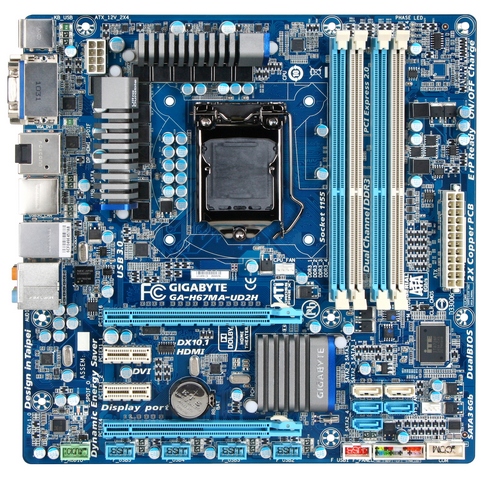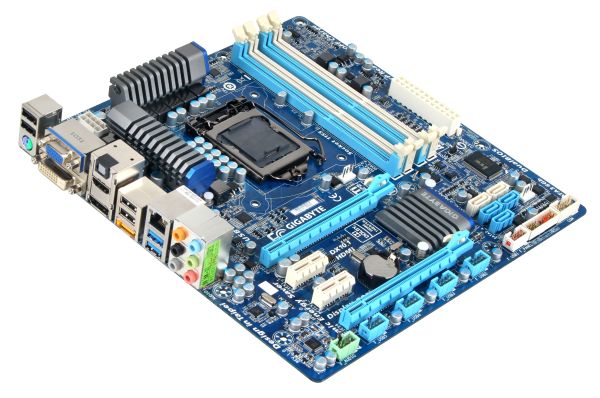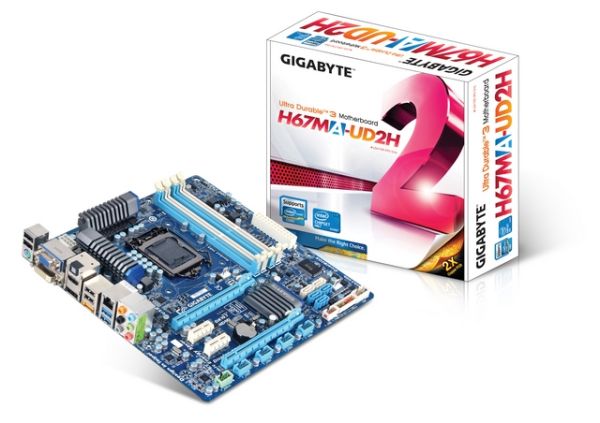H67 – A Triumvirate of Tantalizing Technology
by Ian Cutress on March 27, 2011 6:25 PM EST- Posted in
- Motherboards
- Sandy Bridge
- H67
Overview
The Gigabyte H67MA-UD2H is technically one of sixteen (!) H67 products that Gigabyte have listed on their website. Due to the issue regarding Intel and the chipset recall, Gigabyte have re-released all their boards with the new B3 stepping, and modified their name to match. So the H67MA-UD2H we are testing here is the equivalent of the H67MA-UD2H-B3, but in reality they are the same motherboard, and perform the same, apart from the minor chipset error changed. We expect the UD2H-B3 version to retail at the same as well - $125.
The UD2H has a similar issue to the other two boards tested here today, in that while it states in the BIOS that under single thread loads, the processor should invoke its turbo mode from 33x multiplier base to 37x. In reality it stays for most (98%+) of the time at the 36x multiplier, and very rarely hits 37x, even for short periods of time. I was initially told by ASRock that this is an Intel specification, and it does seem that way. As a result, I can only conclude that by buying a H67 board, consumers are losing that last turbo boosted multiplier under single thread environments. Tsk.
After testing the motherboard, it was a mixed bag of joy and disappointment. On the one hand, the UD2H was the only board out of the three H67 we test here that allowed some form of CPU Overclocking. At first glance in the BIOS, I thought it was better than expected given some of the options (it looked like I could set the CPU to the max turbo multiplier for 100% of the time), but delving deeper I discovered this was not the issue. The 3D performance wasn’t stellar, and the motherboard only has two fan headers on board, meaning my Corsair H50 could only have both fans rotating with an additional 3-pin to molex connector. The design is also a little different…
Visual Inspection
Gigabyte has taken a different tack to ASRock and ECS is our little H67 combined product review – the layout of the board is different (PCIe x4 instead of a PCI) for a start. The SATA ports are all further into the board, and the RAM slots are further away from the 24-pin power connector, leaving a relatively large gap on the board.

With the SATA ports further into the center of the board, and also angled 180° compared to previous manifestations I have encountered, it makes it a little trickier to fit cables in when the board is in a case and a dual slot GPU is present. The PCIe configuration is x16, x1, x1, x4 (electrical), and thus does away with the PCI slots seen on the other boards. Technically these boards do not support Crossfire, and I attempted to fit two GPUs into the board for testing. However, my 5850s are long, dual slot GPUs, and obscure the SATA ports which prevent me testing. Perhaps two short, single slot cards would fit, but unfortunately I have none available to test with.
Another point of interest is the board color – Gigabyte are known for their black and blue boards. But as seen in my review of the P67A-UD4, Gigabyte was veering towards a purely black scheme, as it apparently helps overclocking, according to Gigabyte. As H67 is not a CPU-OC chipset, Gigabyte may have forgone the 10¢ of color and passed the savings on to the consumer. Possibly.
Along the bottom are a plethora of USB headers, but no fan headers. In fact, this board is somewhat lacking fan headers – there is one for the CPU, which is oddly south of the CPU socket, and another next to the SATA ports. Trying to fit a Corsair H50 required some deft placing of the cooler or a fan extension lead, and the second fan required a 3-pin to molex connector.
While no legacy floppy drive connector on board, the PS/2 port in here, along with four USB 2.0 ports, two USB 3.0 ports, the four standard H67 video outputs (D-Sub, DVI-D, HDMI and DisplayPort), a SPDIF_OUT port, an eSATA 3Gb/s port, and the standard Realtek audio inputs and outputs. While there is not a Clear CMOS button, the onboard systems are quite handy at moving into a bootable mode when unbootable settings are chosen.













56 Comments
View All Comments
DominionSeraph - Monday, March 28, 2011 - link
Did you know that the laptop that is a college student's constant campus accessory is.. get this.. a computer?This isn't 1980. A laptop's a given either way.
Wilberwind - Sunday, March 27, 2011 - link
oh noes...that Console vs. PC debate again...Consoles are great for playing with friends. I have both, but If you're using a PC for work and internet, why not just spend a little more and make it into a cheap gaming rig?dingetje - Sunday, March 27, 2011 - link
consoles are great...for retarded kidssilverblue - Monday, March 28, 2011 - link
Just because someone chooses to play games on a console, doesn't make them retarded. You spent more money for a machine that will be utilised far less than theirs and doesn't lend itself as well to communal entertainment, but I'm not going to judge you or anyone else for whatever gaming option they've opted for.silverblue - Monday, March 28, 2011 - link
"utilised" i.e. the developers will generally program consoles to their strengths, whereas you have to hope the developers pay even half the attention to even one component in yours, be it CPU or GPU. Nothing's perfect, however for all the downsides of having a locked system, the ability to develop for only one or two permutations of hardware allows a studio to work at ekeing out every last amount of power from a supposedly limited machine.Voldenuit - Sunday, March 27, 2011 - link
Intel's hare-brained chipset segmentation strategies = failsauce.Taft12 - Monday, March 28, 2011 - link
... and don't forget -- preventing others from producing competing chipsets = monopolyabusesaucemariush - Sunday, March 27, 2011 - link
Page 8:Along the bottom are a plethora of USB headers, but no fan headers. In fact, this board is somewhat lacking USB headers – there is one for the CPU, which is oddly south of the CPU socket, and another next to the SATA ports. Trying to fit a Corsair H50 required some deft placing of the cooler or a fan extension lead, and the second fan required a 3-pin to molex connector.
Surely you mean "this board is somewhat lacking FAN headers", or it doesn't really make sense
KaarlisK - Sunday, March 27, 2011 - link
Does the power consumption at idle increase when overclocking the GPU?If the overclock affects the turbo frequency, it should not change. If the overclock changes the base frequency, I have no idea.
Concillian - Monday, March 28, 2011 - link
I really do not understand Intel's target with the H67.H61 is for the budget person + single GPU
P67 is for the overclocker with plenty of money to donate on a motherboard almost $!00 more expensive plus a CPU that has a price adder as well.
H67 is for the IGP overclocker? Wha?
The review is fine, but the products reviewed have no real target market in my mind. It's a marketing stunt that I'm surprised Anandtech didn't call them on by including an H61 motherboard here and pointing out that the real value, if there is one in this Intel generation, is H61.